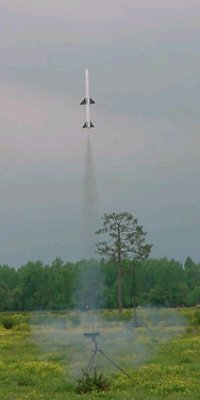The Launch Pad Sparrow AIM-7F
The Launch Pad - Sparrow AIM-7F {Kit} (K057)
Contributed by Jason Myers
| Construction Rating: | starstarstarstarstar_border |
| Flight Rating: | starstarstar_borderstar_borderstar_border |
| Overall Rating: | starstarstarstarstar_border |
| Diameter: | 2.60 inches |
| Length: | 46.75 inches |
| Manufacturer: | The Launch Pad  |
| Skill Level: | 3 |
| Style: | Scale |
 Brief:
Brief:
Single stage, chute recovery kit. Skill level 3 mid-powered kit.
Construction:
This kit came with 2 pieces of thin walled 2.56" body tubes. It utilizes 4 tail fins and 4 large canards mounted at the mid point of the body. Included was a 24" piece of elastic (Estes) shock cord, a standard Estes size 24mm motor tube, a sleeve that formed part of the tailcone that reduced diameter from 2.56" to 2", 4 laser cut carbon centering rings and a carbon bulkhead piece to keep the chute from going too far aft during liftoff.
It also came with a very rounded Harpoon style nosecone. The instructions called for cutting a pattern out of card paper and painting it with CyA glue for stiffness. I opted to replace this nosecone with an LOC/Precision nosecone. I'll use the one that came with the kit for a scratch build sometime.
I also canned the sleeve tube and centering rings to upgrade the motor mount to 29mm and fabricated my own tailcone out of 1/8" plywood and 2 part foam. I added balsa spars to help shape the tailcone and used a finishing sander to quickly and smoothly shape the foam.
I also opted to use a combination of Kevlarline and nylon rope instead of the elastic for the shock cord.
The complexity of this kit was a little bit of a surprise to me when I opened it. I was pretty new to rocketry and didn't read any reviews of these kits.
You do have to trace patterns and cut the balsa pieces by hand, there are no die cut fins. Which isn't that big a deal.
The instructions are fairly straightforward, but some more pics of things like the tailcone and nose cone assembly would be helpful.
I was rather surprised at the size of this rocket. Surface mount fins would be pretty weak on this thing, so I did do a wrap of 2 oz. glass on the body and also glassed the fins and canards on for extra strength as I wanted to fly this on larger than spec'd motors.
Finishing:
For finishing, I used Krylon spray primer and paint. I just did a white body with black fins. I will probably sand it down and repaint with a more realistic light gray body. There were no decals with the kit, so I have not done any yet. I do have pictures (thanks Carl!) of a real Sparrow missile that I will use when I get around to doing a different paint job.
Construction Rating: 4 out of 5
Flight:
I've only flown it once so far. I used an E28-4 and after the modifications I made to this bird, it was barely enough. It flew to maybe 200' and did eject at apogee. It took another second for the chute to pop out (whew) and landed a little hard with the 30" AT chute I used. It cracked a fillet on on of the tail fins. I fixed it after the launch and it's ready to fly again. I'd like to try it on an F-40 next time.
Recovery:
I substituted the elastic shock cord for some Kevlar thread from Pratt Hobbies and also added about 5' of nylon rope. I also used an AT 30" nylon chute. The shock cord appeared to work great and the chute deployed as planned, but next time, I might need to go a little large on the chute as it came down a little hard. I would bypass all of the stock recovery pieces. I did use the mylar chute on another rocket I have and it worked good on the first launch, but the shroud lines tore through the mylar on the second attempt. I personally wouldn't trust mylar for a chute again.
Flight Rating: 2 out of 5
Summary:
Overall, I love the way this kit looks. The flight I did with it was awesome! It went straight up off the pad and never wavered. It's a great kit for the money and a good challenge to the average builder. I plan on purchasing more kits from The Launch Pad!
Overall Rating: 4 out of 5
 |
 |
Flights
Sponsored Ads
 |
 |











